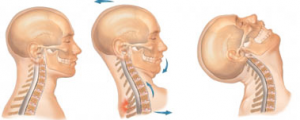WHIPLASH TREATMENT INFORMATION
By definition, whiplash is a “hyperextension and flexion injury to the neck, often a result of being struck from behind, as by a fast-moving vehicle in a car accident.” In most cases, this kind of injury is normally a result of a sudden distortion of the neck, in typical cases  resulting from a rear end car crash.
resulting from a rear end car crash.
At times, whiplash may be referred to as a neck sprain or a neck strain. In most cases, whiplash usually affects people who have undergone automobile accidents. In fact, it may also include injury that affects intervertebral joints, discs and ligaments as well as cervical muscles and nerve roots.
The common symptoms that accompany whiplash include: neck pain especially after the injury, neck stiffness and spasms, specific injuries to the muscles as well as the ligaments, headache and dizziness as well as abnormal sensations that include burning or prickling and back pains.
It is also common for some people to go through cognitive, somatic as well as psychological conditions that may include memory loss, concentration impairment and nervousness or irritability. In some cases, people suffering from whiplash also suffer from sleep disturbances, fatigue and depression.
Fifteen percent of the time, whiplash results in chronic neck pain. This can lead to daily pain, depression, and disability.
What causes whiplash?
Scientists are still in the process of conclusively determining what exactly causes whiplash. There have been multiple theories over the years that have tried to explain the origin of the trauma related disorder. Of these theories, the one holding most water links ligament stretching and injury to the disorder.
In most cases, the anterior longitudinal ligament is normally stretched and in some cases tears. At this point, the head snaps forward followed by another snap to the back, which is thought to be the main cause of whiplash injury.
A number of the recent studies that have employed the use of high-speed cameras to try and decipher exactly what happens during the injuries. During these tests, dummies were crashed and it was determined that after the rear impact to the lower cervical vertebrae, the most common reaction is that these bones are forced into a position of hyperextension.
At the same time, the upper cervical vertebrae fall into a hyper flexed position. The result of these changes in the normal alignments of the bone is an abnormal S-shape in the cervical spine. Scientists believe that this abnormal motion is the real cause of whiplash since it affects the soft tissues that bind the cervical vertebrae together.
Whiplash injury that arises from an automobile accident is normally referred to as cervical acceleration-deceleration injury. What comes out of all these types of whiplash injuries seems to point to the fact that any kind of movement that makes the neck and the head move in different directions rapidly.
Along with ligamentous injury, there appears to often be damage to the cartilage in the facet joints themselves. This may lead to post-traumatic arthritis and explain the percentage of whiplash victims who go on to develop chronic neck pain.
What is the treatment for whiplash?
The most common treatment for whiplash is the use of medication, especially pain medication, which works by targeting the muscles that have been hurt. However, there are a number of different medication types that can be used in the treatment of whiplash. Some of these methods include:
the use of non-steroidal anti-inflammatory drugs (NSAIDS), antidepressants, narcotics and muscle relaxants.
In some cases, a patient may be required to wear a cervical collar for about 2 to 3 weeks. In addition, persons who suffer from whiplash may also be helped with range of motion exercises that may include physical therapy as well as chiropractic manipulations.
Cervical traction may help substantially and be in the form of spinal decompression therapy, which involves intermittent spinal traction.
This can avoid muscle spasms and  what is known as “guarding”. Medical practitioners may also choose to use heat application to relieve the pain that often comes with cases of whiplash.
what is known as “guarding”. Medical practitioners may also choose to use heat application to relieve the pain that often comes with cases of whiplash.
Acupuncture is a treatment that has been around for over a thousand years, and may help mitigate the pain from whiplash. Interventional treatments may include trigger point injections, medial branch blocks or facet injections. A recent study presented at the World Congress of Pain showed that pulsed radiofrequency ablation permits pain relief from whiplash in most patients for months at a time.
What is the Prognosis for Whiplash?
A simple look at the prognosis of whiplash exudes a lot of hope for those who suffer from  this condition. In most cases, the prognosis is actually very good; in fact, the neck as well as the head pains often clears in a few days or weeks.
this condition. In most cases, the prognosis is actually very good; in fact, the neck as well as the head pains often clears in a few days or weeks.
A look at the numbers around the world reveals that patients who suffer from whiplash have a tendency to recover fully in just about 3 months. Patients should also remain aware that they may experience a little residual neck pain and headaches over the following months or days.
Unfortunately, 15% of the time, whiplash turns into chronic neck pain. With appropriate early treatment, the chances of that happening diminish.
There is a lot of research going on into the effects and the issues surrounding whiplash,  with organisations such as NINDS conducting and supporting research in this field and on other trauma-related disorders. This research has especially focused on the scientific understanding of such trauma related disorders, looking into ways in which these kinds of trauma can be prevented and treated.
with organisations such as NINDS conducting and supporting research in this field and on other trauma-related disorders. This research has especially focused on the scientific understanding of such trauma related disorders, looking into ways in which these kinds of trauma can be prevented and treated.
 with organisations such as NINDS conducting and supporting research in this field and on other trauma-related disorders. This research has especially focused on the scientific understanding of such trauma related disorders, looking into ways in which these kinds of trauma can be prevented and treated.
with organisations such as NINDS conducting and supporting research in this field and on other trauma-related disorders. This research has especially focused on the scientific understanding of such trauma related disorders, looking into ways in which these kinds of trauma can be prevented and treated.

 resulting from a rear end car crash.
resulting from a rear end car crash. what is known as “guarding”. Medical practitioners may also choose to use heat application to relieve the pain that often comes with cases of whiplash.
what is known as “guarding”. Medical practitioners may also choose to use heat application to relieve the pain that often comes with cases of whiplash. this condition. In most cases, the prognosis is actually very good; in fact, the neck as well as the head pains often clears in a few days or weeks.
this condition. In most cases, the prognosis is actually very good; in fact, the neck as well as the head pains often clears in a few days or weeks.